#medieval elephant
Explore tagged Tumblr posts
Text

an elephant carrying a house
in konrad von megenberg's "buch der natur", german illustrated manuscript, ca. 1442-1448
source: Heidelberg, Universitätsbibliothek, Cod. Pal. germ. 300, fol. 95 recto.
#medieval elephant#elephant#illuminated manuscript#medieval art#das buch der natur#15th century#manuscripts#medieval illumination
112 notes
·
View notes
Text

Barrel-Nosed Oliphants (or Barrelnose or Barrel-Nosed Snouter) are found in a wide variety of ecosystems, from scablands to hair fields, always snuffling about in search of food. Unlike other members of their family, the Barrelnose is a short, squat species, lacking long legs and intimidating height. Instead, they rely on bulk and brute force, using their hefty short frames to muscle through the undergrowth and bully other animals that may try to take advantage of them. Their trunk serves as nose and mouth, sniffing out morsels to suck up and digest. They feed on vegetation, small animals and fluids, snorting up anything that looks tasty. With no strong jaws or teeth, oliphants rely on a crude "gizzard" and muscle contractions to pulverize prey and hard foods. It is crushed and mashed into a fine paste that can be sucked into the stomach. In cases where the inhaled object is too hard to mush, the Barrelnose will eject it with a "sneeze," sending the offending item flying.
Though they may be smaller than their brethren and less imposing, the Barrel-Nosed Oliphant makes up for it with their bulk and stubborn nature. Threats or annoyances are met with trunk swats and perhaps a angry charge. They possess large tusks that they use to ram attackers or even skewer larger foes. A favorite tactic of theirs is to inhale rocks and hard objects, then fire them at enemies with a powerful sneeze. With such a wide flaring trunk, their aim isn't great, but a spray of stones and shrapnel is enough to make any predator think twice. Their thick muscle and tough hide also make them resilient, as they seemingly shrug off injuries. With all this, the Barrelnose is seen as an angry grump that should be given a wide berth, lest they charge you and break your shins.
While their size does not make them suitable as mounts, the Barrel-Nosed Oliphant has been found to have its uses. Some folk have used them for sniffing out buried vegetables or other foods, sharing the spoils when a cache is found. Others find them useful guard dogs, as their trunk helps sniff out intruders and their angry attitude means they won't hesitate to attack. There is even a breed of Barrelnose that has been trained for battle, using its powerful trunk to fire off projectiles at advancing foes. And if they aren't being domesticated, they are being hunted, as their meat and tusks are quite useful. Oliphant gizzards are a delicacy, and can fetch a high price if you know how to harvest them right. However, these snouters do not go down easy, and will totally turn the tide of a hunt if you are not smart. Like all oliphants, the Barrelnose has an incredible memory and the ability to hold a grudge for a looooooong time. The lesser dragons can tell you that.
----------------------------------
"Barrel-Nosed Oliphant"
Getting busy over here, so we be submitting some of my shorter entries for the time being. Sorry, but please enjoy this squat angry elephant boar.
18 notes
·
View notes
Text
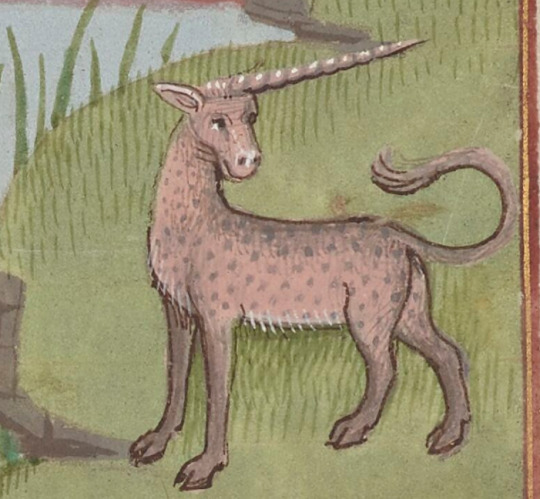
The "animals of India", from a late 15th-century manuscript of Le secret de l'histoire naturelle contenant les merveilles et choses mémorables du monde Origin: France Date: c. 1480-1485 Now Paris, BnF Fr 22971, f. 31r

#unicorn#unicorns#medieval unicorn#elephant#medieval elephant#global middle ages#manuscript#illuminated manuscript#15th century
46 notes
·
View notes
Text
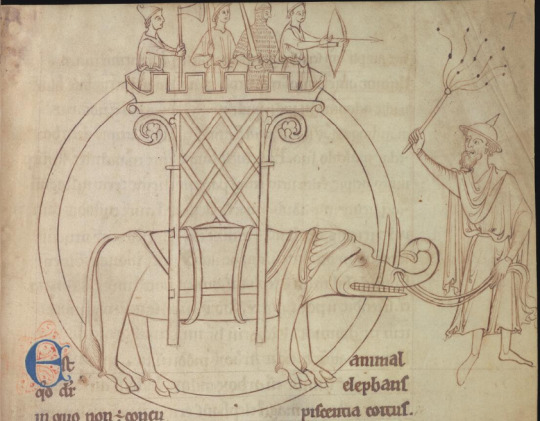
Smile! You are in a bestiary! This particular bestiary-- possibly made in Lincoln-- has been influencing authors and artists for about 800 years. It was the subject of a facsimile by M.R. James (yes, that M.R. James the ghost story writer, who was a librarian in his day job). It was then translated by T. H. White (yes, that T. H. White, the author of The Once and Future King which inspired both Walt Disney and the creators of the musical Camelot).
The text on the elephant covers a lot of elephant myths and legends (and some historical kernels). It starts by announcing that elephants do not like to copulate, then covers their name,
"People say that it is called an Elephant by the Greeks on account of its size: you see, a mountain is called "eliphio" in Greek. In the Indies, however, it is known by the name "barus" because of its voice-- whence both the voice is called baritone and the tusks are called "ivor" [ebur in Latin]." ~T.H. White (trans. and ed.), The Book of Beasts: Being a Translation from a Latin Bestiary of the Twelfth Century (Parallel Press: Madison, Wisconsin, 1954; reprinted 2002), p. 25.
The text then goes on to discuss elephants' size, use in Indian and Persian armies, memory, fear of mice, gestation time, and support for each other. The text also notes that they never "quarrel with their wives" not commit adultery, while explaining Christian allegories about snakes as Satan and elephants as representing Christians, Adam and Eve, the Old Testament, 12 Apostles, Jesus, and the Good Samaritan. With such a repository of elephant lore, no wonder this book has inspired authors through the centuries.
Date: start of the 13th century (c. 1220?) Origin: England (Lincoln[shire]?) Now Cambridge University Library, MS Ii.4.26, f. 7r
#elephant#elephants#medieval elephant#illuminated manuscript#manuscript#war elephant#13th century#t h white#m r jame#once and future king
16 notes
·
View notes
Text
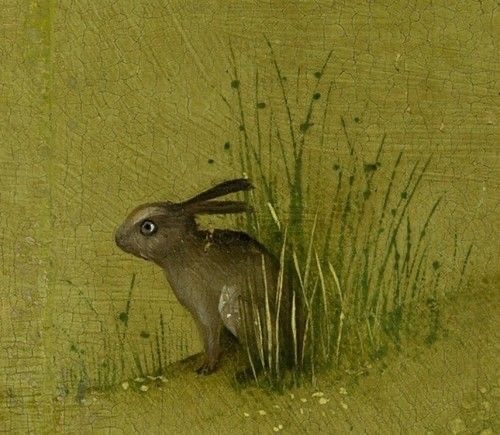
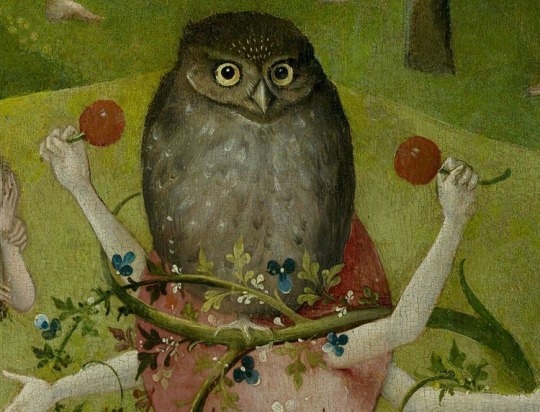




Animals of the “Garden of Earthly Delights”
Hieronymous Bosch ca. 16th century
#art history#art#cat art#history#medieval#animals#hieronymus bosch#bosch#elephant#owl#animal art#weird art#renaissance#renaissance art#garden#history of art#fine art#european art
2K notes
·
View notes
Text
#TwoForTuesday:

Two Elephants: fol. 99 in Ms. Ludwig XV 3 (Bestiary), Flanders, c.1270 Tempera colors, gold leaf, ink Getty 83_MR.173.99
"Elephants picking and eating fruit from a tree. This image shows the artist had some idea of how elephants use their trunks to deliver food to their mouths. This is a very unusual elephant illustration." (description via https://bestiary.ca/manuscripts/manugallery378.htm)
#animals in art#european art#miniature#illuminated manuscript#medieval manuscript#medieval art#medieval bestiary#bestiary#Flemish art#Getty Museum#Two for Tuesday#elephant#elephants#pair
55 notes
·
View notes
Text

fuck it. plaguesona
#i thought of this a couple weeks ago on the bus a couple seats away from someone loudly coughing into the open air#i think something snapped and i decided to make a fuckin. medieval ass plague sona. horseman of pestilence fursona#this is also why i was asking abt animals with medical symbolism.. originally i wanted a two headed snake like the staff of caduceus#but it turns out thats actually hermes symbol. the real symbol for medicine is the rod of asclepius which looks pretty similar#the difference is that theres only one snake and its twined around a stick. ironically mercy from overwatch's weapons are named after#the caduceus despite the misconception LMAOOO#snakes were the most consistent medicine related animal i could find even across multiple cultures so it couldve really worked#if i could actually draw scalies.. one of my earliest sketches had a cobra with a syringe at the end of its tail like a rattlesnake#and it had markings similar to the syringe tube but i didnt have much else going on so i scrapped it#i was also recommended animals with less obvious ties to medicine like jellyfish and horseshoe crabs and learned something new ^_^#im not confident i could pull off a non-mammal furry but they were really good ideas i might put into smth else.. i also thought of#axolotls bc of their regenerative thing and growing back limbs but i think that would suit smth like a surgeon or amputation...#possums and bats were also an option bc theyre actually really resistant to most diseases like rabies but i feel like ppl wouldnt know that#if they saw it so it looks a little ironic at a glance. rabbits rats and mice were my second option bc of animal testing and lab rats#less obvious reference but the moon rabbit in chinese mythology is loosely connected to medicine bc it makes the elixir of life#otherwise lab mice in a pharmacy / modern medicine setting seemed fitting and jerboa tails remind me of cotton buds#and. ironically. jerboas are more closely related to elephants than rats and mice. can you believe it#my art#myart#my oc#sona#plaguesona#cottonbud#fur#furry art#character design#ref sheet#oc ref sheet
139 notes
·
View notes
Photo

Elephant Fish, in: Church of Saint Martin in Zillis, Switzerland, 12th century
The painted ceiling of the Church of Saint Martin serves as a sort of medieval bestiary. Surrounding the Earth on the church ceiling is an ocean populated by an assortment of hybrid creatures, each one a land animal mixed with a fish. The ceiling boasted a horse fish, goat fish, rooster fish, etc. One of the hybrids was an elephant fish.
This picture suggests that the painter had some idea of what an elephant trunk looks like — notable since medieval Europeans didn't often see elephants. It also reflects the belief common at the time that every land-dwelling animal had a marine counterpart.
96 notes
·
View notes
Text
THIS boi....

But the alt text!!! 😂

3 notes
·
View notes
Text

Here's Abul Abbas, an elephant who was a gift from the Muslim Caliph Haroun al-Rashid to the Frankish emperor Charlemagne around the year 800. Abul Abbas traveled over land from Baghdad to France in the company of Charlemagne’s diplomat Isaac the Jew.
Charlemagne supposedly traveled with the elephant — possibly even using him in battle — for about ten years until Abul Abbas died. Like a lot of other animals, Abul Abbas’ legend lasted for centuries. Here’s a Spanish image of him from about four centuries after he lived.
{WHF} {Ko-Fi} {Medium}
71 notes
·
View notes
Text

From this week's Maniculum Bestiaryposting Challenge, the Dikebael!
We don't learn a lot about this animal, only that it is very big and lives in Africa. So how could I pass up the opportunity to draw another elephant? This one is based on the Worksop Bestiary, mostly because I liked the pretty ears.
One thing that the description specifies is that it calls during the day and night of March 25th, which I assumed to be a reference to the Annunciation. One of my favorite depictions is the Annunciation with St. Margaret and St. Ansanus. I just love her expression (which the article describes as "graceful and composed reluctance, looking with surprise at the celestial messenger". Sure). And as a celestial messenger, the Dikebael gets pretty wings too.
The Dikebael also supposedly conceals her children "in secret places", lest the jealous males "bite off their testicles" (biting off testicles seems to be a theme in this bestiary somehow). Luckily, they have those convenient big ears to hide behind!
17 notes
·
View notes
Text
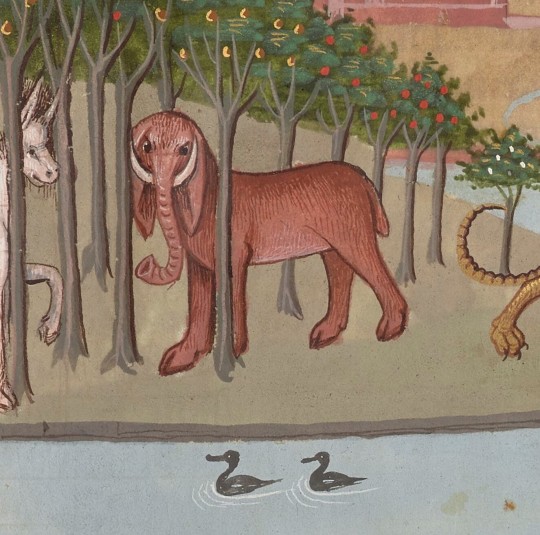
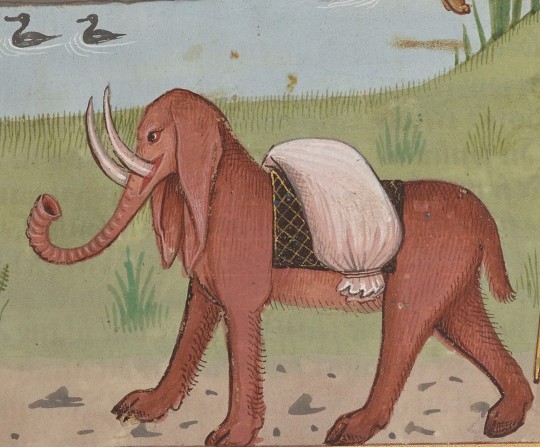
elephants and ducks
in "le secret de l'histoire naturelle [...]", illuminated manuscript, france, 15th c.
source: Paris, BnF, Français 22971, fol. 31r
for more medieval elephants go check out @medieval-elephants! :)
936 notes
·
View notes
Text
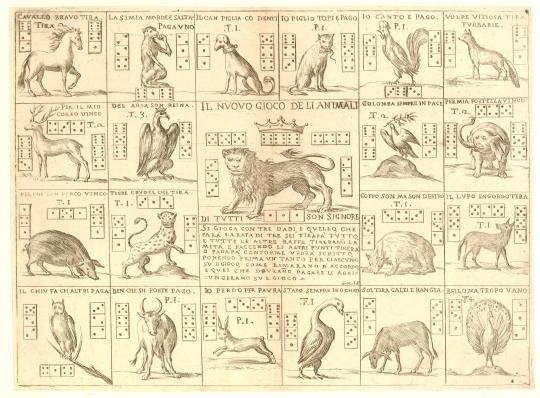
Il nuovo gioco de li animali (1690-1718) Giuseppe Maria Mitelli
#animal#animals#medieval animals#lion#horse#deer#bird#pig#boar#bull#rabbit#peacock#wolf#elephant#medieval board game#medieval#engraving#engraving illustration#engraving art#medieval art#middle ages#medieval illustration#medieval engraving#1600s#1700s#board games
11 notes
·
View notes
Text
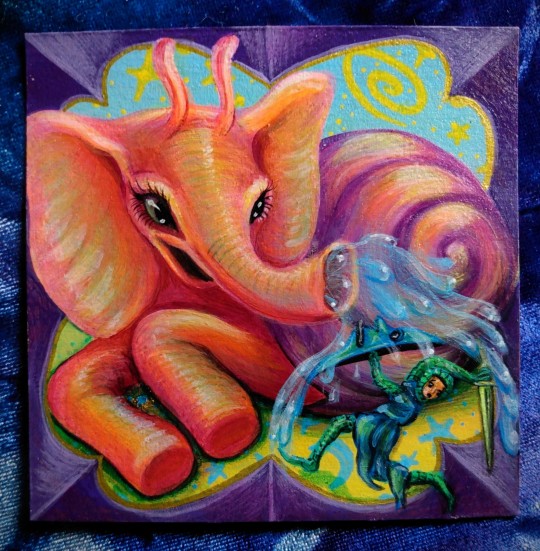
🐘 HYBRID SNAIL 🐌 Day 3 of Weird Medieval October!
Acrylics on paper, 3x3"
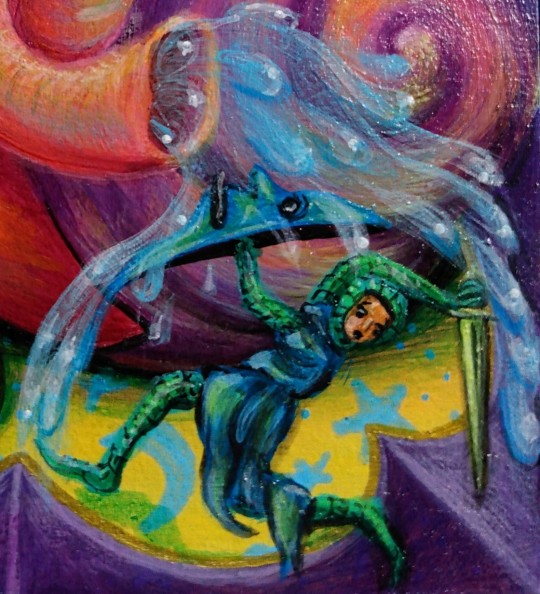
#medieval art#elephant#knight#snail#my art#mini painting#miniature art#artists on tumblr#painting#pop surrealism#agblend13#traditional art#acrylic painting#lowbrow art#traditional painting#fantasy art#scifi fantasy#colorful#rainbow art#kawaii#cute art#swords#weird medieval october
10 notes
·
View notes
Text

Big in (6th-century) Japan
I'm currently working on an article about elephant motifs in the British Isles before 1300 AD. Elephants were rarely seen in northern Europe in the early Middle Ages, yet they routinely featured in northern European art and writing, inspired by early Christian and classical texts. What might these elephant motifs indicate the travel of goods, people and ideas from the east to west and from south to north in the world before globalization?
Recently, I have also been thinking about a comparative example of elephant motifs travelling west to east: from mainland Asia to Japan. In some ways, the spread of elephant motifs to the islands of Japan paralleled the spread of elephant imagery to the British Isles: Martha Chaiklin has suggested that may elephant motifs were brought along with religious traditions from areas where elephants abounded. In particular, elephants feature in some Buddhist imagery. (Similarly, early Christian writers' use of elephants as metaphors may help explain why Old English has a special word for an animal that the vast majority of its speakers never physically saw.) That being said, elephant motifs existed in Japan before the spread of Buddhism. Mirrors from as early as the fourth-century depict creatures with long trunks. These depictions were possibly influenced by textiles or other goods from Korea or China.
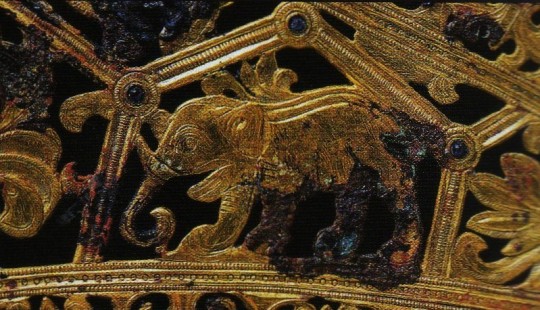
Meanwhile, a richly furnished, sixth-century tomb discoverd in Fujinoki contained, among other things, a saddle depicting elephants and other creatures, as shown above. (Image source x.) The identity of tomb's original occupant is highly debated, but they seem to have had links with the Paekche (Baekje) kingdom in Korea. Edward Kidder notes many of the items in the tomb seem to have links to Paekche styles or origins. (And of course, elephants were distant from Korea, too, so their imagery came through China and maritime routes. The Paekche leaders were also Buddhist and promoted Buddhism in Japan...)
So while religion and rituals were powerful forces for spreading iconography and knowledge of far-off regions, so were economic ties and exchange. Which came first? Or can we even separate ritual, wealth, and power for the high elites (which the occupant of the Fujinoki tomb definitely was)?
Works Cited Martha Chaiklin, "Elephants under the rising sun: pachyderms in pre-modern Japan", The SOAS Elephant Reader (February 2021). J. Edward Kidder, “The Fujinoki Tomb and Its Grave-Goods.” Monumenta Nipponica 42, no. 1 (1987): 57–87. https://doi.org/10.2307/2385039
10 notes
·
View notes
Text

(via)
2 notes
·
View notes